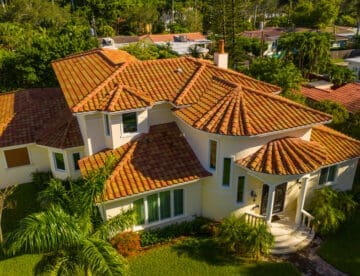Mineral surfaced roll roofing is inexpensive and easy to install but will typically not last more than 10 years. This is because a maximum of 2 layers is used, and you use fewer nails than other types of roofing systems. Roll roofing systems also blow off more easily in high winds and hurricanes. Because roll roofing systems are continuous, any weakness such as a tear can compromise a large area therefore it is very important to replace damaged roll roofing to protect the underlying deck.
Mineral-surfaced roll roofing has commonly been used as underlayment for long-life roofing systems such as tile roofs. As long as the granules protect the roll roofing base, mineral surfaced roll roofing functions well as underlayment. However, with modernized roofing technology most roofers are using underlayment specifically designed for tile roof and other long-life roofing systems.
Mineral-surfaced roll roofing is made out of the same materials as asphalt shingles. You can use it as a single or double-coverage roofing material, or for valley flashing.
Single-coverage rolls (one factory roll per square) are typically 3 feet wide and 26 to 38 feet long and weigh anywhere from 40 to 90 pounds per roofing square. The most common roll roofing is the 90 pound roll. If a roll is being used for single coverage, the exposed face is covered entirely with crushed slate embedded in a coat of asphalt.
The double-coverage rolls have 17 inches of the 36 inch face is covered with granules so that the rolls can overlap to create a double coverage roofing system. The remaining 19 inches (selvage edge) may have a number of different finishes which is free of any granules and coated or saturated with asphalt. Selvage roll roofing usually comes in rolls that are 36 inches wide, and come in lengths of either 18 or 36 feet. Selvage roofing rolls usually weigh from 55 pounds to 70 pounds per square.
Pattern-edge roll roofing comes in 36 inch wide rolls that are 42 feet long or the come in 32-inch wide rolls that are 48 feet long. Pattern-edge roofing rolls weigh about 105 pounds per square. Once side of the roll is mineral surface except for a 4 inch strip. You cut the rolls in half so that you get two strips that are 18 inches wide with 16-inch exposure and a 2-inch top lap. If you are using a 32-inch roll you will get 16-inch strips with 14 inches of exposure and a 2-inch top lap. Including waste, one factory square will cover 100 square feet of roof area.
Roll roofing materials should be stored upright in a dry cool area. You don’t want to store them lying down because the material will eventually flatten out, especially in a warm humid environment. If you must store the materials outside you should put them on a raised platform above the ground, keep them covered to protect them from the weather, and NEVER store them in the hot sun.
Asphalt mineral-surfaced roll roofing has almost completely been replaced with Modified Bitumen Asphalt (MBA) roll roofing. It is made of a rubberized asphalt mat and reinforced with fiberglass and surfaced on one side with mineral granules. Each roll weighs about 110 pounds. The MBA rolls are installed over a 45 pound base sheet and roll on cold applied bitument. You can also torch down the material. You use a blow torch to heat the base sheet as you walk the MBA roll over and onto the base sheet. The torch heast the asphalt in the base sheet and makes the base sheet and the MBA roll stick together. MBA rolls can be used on flat roofs. The rolls should be overlapped by about 4 inches and the edges should be lapped by about 12 inches. The laps should be adhered with cold applied bitumen and the rolls should be walked down into the cement.

